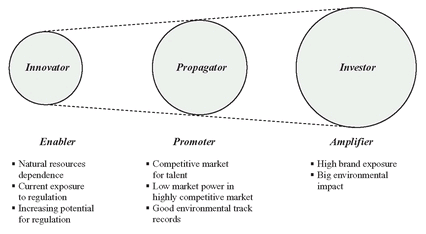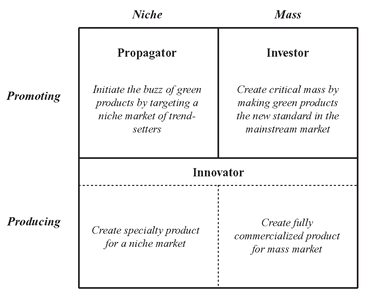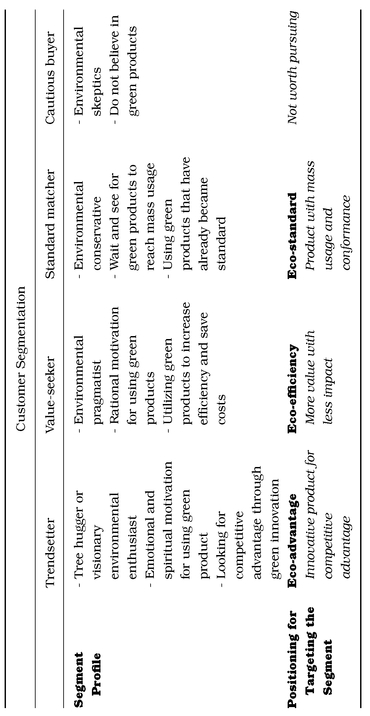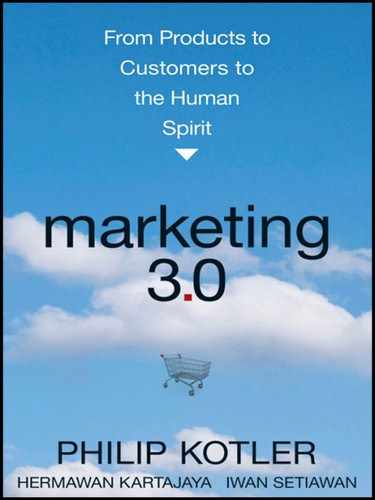CHAPTER NINE
Striving for Environmental Sustainability
Another way to make a difference is to solve one of the biggest global issues of our times: environmental sustainability. Many companies have not started to think seriously about making their processes friendlier to the environment. Some companies felt the pressure and scrutiny and knew they had to do something before being spotted and publicly embarrassed by environmentalists. At the other end were a few companies that felt that they could take advantage of this public interest by aggressively marketing green-related products and services.
THE THREE ACTORS IN SUSTAINING THE ENVIRONMENT
We will present three cases of larger companies that have created big impacts on the environment—albeit each in different ways. From these three cases—DuPont, Wal-Mart, and Timberland—we can distinguish three roles that companies can adopt to protect Mother Nature—the Innovator, the Investor, or the Propagator.
The Innovator: DuPont Case
DuPont, the science company that has existed for more than two centuries, has dramatically transformed itself from being the worst U.S. polluter to one of its greenest corporations today.1 The inventor of nylon, Dacron, Lucite, Kevlar, Corian, Tyvek, Teflon, and polymer chemistry that would change human lives forever was also the creator of chlorofluorocarbon (CFC) to which the hole in the ozone layer above Antarctica can be attributed. However, today, the company is one of the main drivers of the U.S. Climate Action Partnership (USCAP), which has requested legislation that obliges corporations to apply lower-cost methods that will reduce the greenhouse gas emissions of their businesses. Within DuPont itself, gas emissions have been reduced by 72 percent from 1990 to 2003 and the goal is for a further reduction of 15 percent by 2015.
In addition to its pollution reduction success, DuPont is integrating sustainability as both its operations obligation and its core business model. What is most inspiring is that $5 billion of its $29 billion in revenue comes from sustainable products: products made from environmentally-friendly sources and products that save energy. DuPont has ingrained the mission not only to slow down environmental problems by addressing harmful operations within the company but also to create products that will stop further harm from being done to the planet. As noted by one of DuPont’s executives, “My team knows that when they walk into my office with an idea about a new product, it’d better have a reduced environmental footprint, or they can walk right out. Because [if it doesn’t] I’m not listening!”
DuPont is an example of the environmental Innovator. The Innovator invents/innovates products that have the potential to save the environment, not products that simply do not harm nature and are environmental-friendly. These products reverse the damage done and do not damage the environment in either their production process or in their disposal. Innovators go beyond incremental innovation to develop disruptive innovation. Hart and Milstein label incremental innovation as an attribute in strategies for greening and disruptive or discontinuous innovation as a component in strategies for beyond greening.2
DuPont illustrates the Innovator’s role because of its constant exploration of technologies to create new and better products. It constantly repositions itself to align with the changing needs and themes of the world. When the power of nations was once defined by guns and weapons in the early 1800s, DuPont was a gunpowder and explosives manufacturer. And then in the late 1800s, when war began to incorporate biological warfare and the strongest country possessed the best scientists and discoveries, DuPont transformed itself into a chemical company producing synthetic materials. A century and more later when global warming and cries from environmentalists set in, DuPont underwent its second drastic transformation to become a company that focuses on sustainability by producing energy-saving products.
DuPont has created several products that may potentially reverse some damage done to the environment. One of its products, Tyvek, can be used in new ways to improve energy efficiency. DuPont’s biofuel unit is working to make corn yield more ethanol, finding a cheaper way to produce higher-energy cellulosic ethanol, and partnering with BP on a new fuel called bio-butanol, a high-energy fuel that works in today’s engines. The company has also applied Kevlar, the substance used for bulletproof vests, in fuel-efficient planes.
The Innovator has the scientific capability to contribute to the environment in a way that the Investor or Propagator lack. The innovations produce major impacts on the environment because they are used globally in a long-term manner. Usually, these products take years and even decades of research and an infinite flow of investments. Just as with any invention or innovation project, the results are not certain. Hence, the Innovator usually takes great risks when embarking on a major research project.
Innovators are usually from the chemical/biotechnology /energy/high-tech industries because these capabilities are needed to invent and produce such products. Like Chad Holliday of DuPont, GE’s Jeff Immelt is also embracing the green movement. He drives the company’s efforts to develop everything from energy-saving light bulbs to desalination technology that improves clean water capacity.3 Other companies that are playing an innovator role include Toyota with its hybrid cars, Dow Chemical and its biotechnology investments, and Empress La Moderna, a booming life-sciences company focusing on “green chemistry” research to find biological substitutes for synthetic chemicals.
For the Innovators, innovating for sustainable, environment-saving products forms the core of their raison d’être. That becomes the mission. The Innovator embraces what Walley and Whitehead stated in their Harvard Business Review article, “It’s Not Easy Being Green”: “Being green . . . is a catalyst for innovation.”4
The Investor: Wal-Mart Case
There is also a change occurring in the world’s largest retailer, Wal-Mart.5 Known in the past for its oblivious attitude toward societal and environmental concerns, Wal-Mart has never rated high as a good corporate citizen. Wal-Mart was often criticized for its low wages and its frequent ignorance of environment issues. Robert Greenwald created a film entitled, Wal-Mart: The High Cost of Low Price. In that movie, there is a section highlighting the commentary of one veteran activist who said that she had never come across a corporation as ignorant as Wal-Mart. Even when it cost Wal-Mart millions of dollars in fines for its environmental abuse, the company continued to appear ignorant.
About 8 percent of consumers discontinued their regular shopping visit to Wal-Mart stores because they perceived the company negatively, according to a leaked McKinsey survey. In an attempt to ward off excessive negative publicity and finally address environmental issues, Wal-Mart proclaimed in 2005 that it would become a good steward of the environment. Wal-Mart’s former CEO, Scott Lee, announced in his “21st Century Leadership” speech that Wal-Mart would spend hundreds of millions of dollars to redesign its business model with fuel-efficient processes and good waste management. With this new design, he expected greater efficiency gains to cover the costs.
To achieve this objective, Wal-Mart built green super-centers and introduced green labeled products in its stores. Given its size, Wal-Mart had become the largest retailer of organic milk and sustainable fish in the world in approximately just one year. Wal-Mart had also leveraged its strong bargaining position to force suppliers to find more efficient packaging and processes.
Many are excited about Wal-Mart’s ambitious plans because a small transformation in one of the biggest companies in the world means a big change. The changes have also improved its PR as critics now have more favorable views on Wal-Mart’s approach to social responsibility. However, many critics still say that Wal-Mart, whose classic tagline “Always Low Prices,” drives its business model to only care about costs. Today, the tagline reads “Save money. Live better.” But many see Wal-Mart’s move to save the environment as being chiefly performed for selfish economic goals—to save energy, save costs, and increase revenue from increasing demand for green products.
By definition, the Investor is someone who “puts [money] to use, by purchase or expenditure, in something offering potential profitable returns, as interest, income, or appreciation in value.”6 Although this description may hint at being somewhat negative, especially in the context of giving something back to Mother Nature and not taking more, we do not mean for the Investor to be contributing less than the Innovator.
Investors are companies and individuals that finance research projects (usually by Innovators) in external companies or their own companies. For example, Wal-Mart invested $500 million in 2005 so that its stores can use less energy, its trucks emit less poisonous gas, and so on.7 Just like an Investor, Wal-Mart has calculated the costs and benefits and risks prior to its investment. Others belonging to the group of Investors are Goldman Sachs and Hewlett-Packard. Some manufacturers are also starting to invest to reduce their factories’ gas emissions, reduce use of energy from their stores/computers, and so on.
The Investor will not take big risks in environmental efforts like the Innovator because the green business is not its core business mission. However, Investors share the vision of a greener and sustainable world. Besides seeking financial returns, the Investor also seeks returns in other areas—improvement in image, increase in brand value, avoidance of more pressure from environmental organizations, and selling green products to meet market demand, just to name a few. While Investors are not directly in the product innovation business, they make a major contribution by lending financial resources to support environmentally friendly projects.
The Propagator: Timberland Case
In contrast to Wal-Mart, Timberland is one of the most respected companies by all stakeholders. The global leader in the design, engineering, and marketing of premium-quality footwear, apparel, and accessories for consumers who value the outdoors, it believes in “doing well by doing good.” It has not only been an environmentally-friendly company, but has created awareness about the environment among communities all over the world. It is especially known for its consistency in performing environmentally-friendly activities even through business down cycles.
In the production and promotion of its shoes, Timberland adheres strictly to a green business model. It uses recycled and nonchemical materials extensively in energy-efficient manufacturing processes. Inspired by the nutrition facts on food labels, it has introduced a “nutrition label” on each pair of shoes. The label provides consumers details “about the product they are purchasing, including where it was manufactured, how it was produced, and its effect on the environment.”8
Timberland is very much focused on giving back to the communities in which it operates. With programs such as the Path of Service, Service Sabbaticals, Earth Day, and Serva-palooza, Timberland aims to help underprivileged communities as well as to promote its trademark values, including that of protecting the environment. Under the Path of Service program, Timberland employees have contributed over half a million hours of service around the world. That commitment has helped hundreds of community organizations in dozens of cities. Many of Timberland’s activities involve protecting the environment. During Earth Day, for instance, Timberland planted a tree for each consumer who spent $150 on Timberland products.9 Timberland has also done internal marketing activities such as providing incentives to employees to purchase hybrid cars.
The Propagator is usually a smaller size company in a non-chemical/biotechnology/energy/high-tech industry. The core differentiation usually lies in its green business model, which turns its internal values into external competitive advantage. The Propagator’s mission, other than business, is to create awareness among user groups, employees, and the public about the importance of protecting the environment. It forms the critical mass or the support system that will purchase the products sold by the Innovator and which will support and appreciate the positive contribution of the Investor. Most importantly, Propagators seek to create environmental ambassadors by spreading the values of protecting the earth to employees and consumers.
The common strategy used to create environmental ambassadors is to create awareness in communities. Timberland illustrates the role of the Propagator best. Timberland seeks to inform, inspire, and engage. This is reflected clearly on its web site at www.timberlandserve.com.
Another strategy is bringing attention to the environment through its products. Timberland’s new initiative—what it calls a nutritional label for shoes and boots—is an example. The innovative label tells all about the social and environmental impact that a person makes when buying shoes. While nutrition facts point to the impact of food on your wellness, Timberland’s labels describe the impact of products on the earth’s wellness. All the volunteer programs are reported through this new medium as well.10
Examples of other notable companies in this category are Patagonia, Whole Foods Market, Fetzer Vineyards, and Herman Miller. These companies are well-known for their environmental stewardship in creating more environmentally-friendly business practices.
THE COLLABORATION OF THE INNOVATOR, THE INVESTOR, AND THE PROPAGATOR
Because they have different motivations, the Innovators, the Investors, and the Propagators play their own unique roles in saving the environment. As described in Green to Gold, there are several motivations for companies that are moving toward a greener stance. 11
1. Natural resources dependence
2. Current exposure to regulation
3. Increasing potential for regulation
4. Competitive market for talent
5. Low market power in a highly competitive market
6. Good environmental track records
7. High brand exposure
8. Big environmental impact
Reasons 1 to 3 are the main motivations for the Innovators, reasons 4 to 6 for the Propagators, and reasons 7 to 8 for the Investors (see Figure 9.1).
Figure 9.1 Motivations of Different Actors

Both Investors and Propagators promote the environmental cause through their business processes, whereas Innovators produce products that are environmentally friendly. Propagators play in niche markets whereas Investors play in more mass markets. To create reinforcements of impacts, all three types should exist in the market. The buzz is started by the Propagators, which build their competitive advantage from their concern about the environment. This buzz builds up public opinion for the environmental cause. However, Propagators like Whole Foods Market will take a longer time to bring green products into the mainstream. Without influence from Investors like Wal-Mart, green products will remain exclusive to a niche market. Propagators also need Innovators to supply them with innovative green products (see Figure 9.2).
TARGETING COMMUNITIES FOR GREEN MARKETING
It is important to recognize that the green market is far from homogeneous. The market for green products and services can be classified into four segments: trendsetters, value-seekers, standard matchers, and cautious buyers. Trendsetters are the early market whereas value-seekers and standard matchers are the mainstream market and the cautious buyers are laggards. Because each segment has different sets of beliefs toward product benefit, the marketing approach for each segment should be different. As for the cautious buyers, it is better not to pursue them. See Table 9.1.
Figure 9.2 Collaboration of Different Actors

Trendsetters are the most important segments in the introduction stage of a green product. They become not only the first customers to adopt the product but also the important influencers in the market. Make them promoters who will recommend and endorse the products to their friends and families.
Based on the VALS,12 trendsetters can be classified in the Innovators segment. They are change leaders and are the most receptive to new ideas and technologies. They are very active consumers, and their purchases reflect sophisticated tastes for upscale, niche products and services. However, green products will not take off to the growth stage if they remain in the niche market of tree huggers. As long as green products are the exclusive domain of well-off people, their benefits will be limited. To have an impact, they should be widely accepted in the marketplace. That’s why major corporations are greening their mainstream brands. Take Tide Coldwater, which is formulated to wash clothes best in cold water.13
Table 9.1 Four Segments of the Green Market

Unlike the trendsetter market, which is more emotional and spiritual, the mainstream market is more rational when it comes to buying green products. The value-seeker segment buys green products if they are cost-efficient. Consumers of this type would not pay more to be green. Therefore, green products must be affordable when targeting this segment. Marketers should also be able to point out the cost-savings from using green products.
People who are classified as “thinkers” in VALS are the key target market. They are open to considering new ideas. They are a type of customer who can easily be influenced away from bad decisions and toward more responsible ones. Therefore, marketers should design programs that give them options but steer them away from the bad ones.14 Communicating greener product options in addition to regular ones will lead value-seekers to choose the better options.
However, value-seekers are also conservative, practical consumers; they look for durability, functionality, and value in the products they buy. To engage this segment, green marketers need to put an emphasis on how their product will provide more value with less environmental impact. Therefore, the marketing communication should be themed around the concept of eco-efficiency.
While value-seekers are practical, the standard-matchers are more conservative. They do not buy a product that is not yet a standard in an industry. The product’s popularity is the most important reason to buy. To appeal to this segment, the green product has to reach the critical mass to be considered a standard. It is imperative to have a catalyst. For example, the rise of environmentally-friendly buildings has been largely driven by the development of green building standards. This was pioneered by the U.K. government and followed by the U.S. government. More and more countries such as Australia and India are developing their own green building standards. These trends are moving green buildings into mainstream markets.15
Figure 9.3 The Market Segment Influence Chain

The cautious buyers, the fourth segment, are the customers who are so skeptical that they avoid buying green products although greener business is already an accepted belief. This type of customer is too costly to pursue and convert.
To lead a product across its life cycle means to lead the product across the market segment influence chain (see Figure 9.3). In the introduction stage, marketers need to use green as a key source of differentiation. However, marketers need to use word-of-mouth marketing to create hype and a snowball effect to reach the growth stage. According to Crossing the Chasm by Geoffrey Moore, there is a gap in the market—the chasm—that separates the early market from the mainstream market.16 Green products have to cross the chasm and become popular. Once a product reaches the maturity stage, competition intensifies and marketers need to start finding differentiators other than just being green. (See Figure 9.4.)
SUMMARY: GREEN INNOVATION FOR SUSTAINABILITY
In this chapter, we underscore the importance of values-based companies moving toward a green commitment. Benefits include lower cost, better reputation, and more motivated employees. Companies such as DuPont contribute to the green movement by playing the role of Innovator. Companies such as Wal-Mart contribute by playing the role of Investor. And Timberland contributes by playing the role of Propagator. Having examined the characteristics of these different roles, we argue that when they all operate in the same market and collaborate, that the green market will be reinforced. Finally, companies need to distinguish the four segments in the green market—the trendsetters, value-seekers, standard matchers, and cautious buyers and note their differing behaviors and readiness to buy green products. Companies that promote environmental sustainability are practicing Marketing 3.0.
Figure 9.4 The Life Cycle of Creating Green Awareness and Purchase

NOTES
1 The DuPont Case is mainly written based on an article by Nicholas Varchaver, “Chemical Reaction,” Fortune, March 22, 2007.
2 Stuart L. Hart, “Beyond Greening: Strategies for a Sustainable World,” Harvard Business Review, January-February 1997.
3 Marc Gunther, “Green is Good,” Fortune Magazine, March 22, 2007.
4 Noah Walley and Bradley Whitehead, “It’s Not Easy Being Green,” Harvard Business Review, May-June 1994.
5 The Wal-Mart Case is mainly written based on an article by Marc Gunther, “The Green Machine,” Fortune, July 31, 2006.
6 From www.dictionary.com.
7 “Is Wal-Mart Going Green?” MSNBC News Services, October 25, 2005.
8 Timberland homepage, www.timberland.com, May 11, 2007.
9 Jayne O’Donnell and Christine Dugas, “More Retailers Go for Green—the Eco Kind,” USA Today, April 19, 2007.
10 Marc Gunther, “Compassionate Capitalism at Timberland,” Fortune, February 8, 2006.
11 Daniel C. Esty and Andrew S. Winston, Green to Gold: How Smart Companies Use Environmental Strategy to Innovate, Create Value, and Build Competitive Advantage (New Haven, CT: Yale University Press, 2006).
12 VALS is the system that identifies current and future opportunities by segmenting the consumer marketplace on the basis of the personality traits that drive consumer behavior. See www.sric-bi.com/VALS/ for a more detailed description of the segmentation.
13 Anne Underwood, “10 Fixes for the Planet,” Newsweek, May 5, 2008.
14 Read more about how to nudge customers toward more responsible options in Richard H. Thaler and Cass R. Sunstein, Nudge: Improving Decisions about Health, Wealth, and Happiness (New Haven, CT: Yale University Press, 2008).
15 Charles Lockwood, “Building the Green Way,” Harvard Business Review, June 2006.
16 Geoffrey A. Moore, Crossing the Chasm: Marketing and Selling High Tech to Mainstream Customers (New York: HarperBusiness, 1999).
..................Content has been hidden....................
You can't read the all page of ebook, please click here login for view all page.
